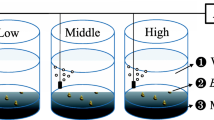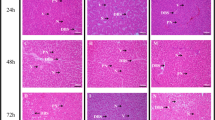Abstract
As an important type of emerging pollutants, ecological toxicity and risk of artificial musks are increasingly concerned. Thus, single and joint toxic effects of 1,3,4,6,7,8-hexahydro-4,6,6,7,8,8-hexamethylcyclopenta-gamma-2-benzopyran (HHCB) as one of the most widely applied artificial musks and cadmium (Cd) as an toxic metal on zebrafish (Danio rerio) were investigated by the exposure of zebrafish to various concentrations of HHCB or/and Cd in feculent water containing bedloads. The results indicated that the joint effect of HHCB and Cd changed during different exposure times within 120 h. The index of the antioxidant enzyme system including superoxide dismutase (SOD) and peroxidase (POD), and malondialdehyde (MDA) were sensitive and induced in the zebrafish stressed by Cd, and content of soluble protein (SP) was sensitive to HHCB and could be used as a biomarker for HHCB. Joint effects on antioxidant enzymes depended more on the effect of single Cd in the first one or two days. However, in the rest exposure days, the effect of HHCB began to dominate in the joint effect during the exposure process.
Similar content being viewed by others
References
Gnecco I, Berretta C, Lanza L G, La Barbera P. Storm water pollution in the urban environment of Genoa, Italy. Atmospheric Research, 2005, 77(1–4): 60–73
Api A M, Ford R A. Evaluation of the oral subchronic toxicity of HHCB (1,3,4,6,7,8-hexahydro-4,6,6,7,8,8-hexamethylcyclopenta-γ-2-benzopyran) in the rat. Toxicology Letters, 1999, 1111(1–2): 143–149
Peck AM, Hornbuckle K C. Synthetic musk fragrances in urban and rural air of Iowa and the Great Lakes. Atmospheric Environment, 2006, 40(32): 6101–6111
Roosens L, Covaci A, Neels H. Concentrations of synthetic musk compounds in personal care and sanitation products and human exposure profiles through dermal application. Chemosphere, 2007, 69(10): 1540–1547
Duedahl-Olesen L, Cederberg T, Pedersen K H, Højgård A. Synthetic musk fragrances in trout from Danish fish farms and human milk. Chemosphere, 2005, 61(3): 422–431
Kannan K, Reiner J L, Yun S H, Perrotta E E, Tao L, Johnson-Restrepo B, Rodan B D. Polycyclic musk compounds in higher trophic level aquatic organisms and humans from the United States. Chemosphere, 2005, 61(5): 693–700
Balk F, Ford R A. Environmental risk assessment for the polycyclic musks, AHTN and HHCB. II. Effect assessment and risk characterisation. Toxicology Letters, 1999, 111(1–2): 81–94
Carlsson G, Orn S, Andersson P L, Soederstroem H, Norrgren L. The impact of musk ketone on reproduction in zebrafish (Danio rerio). Marine Environmental Research, 2000, 50(1–5): 237–241
Yang J J, Metcalfe C D. Fate of synthetic musks in a domestic wastewater treatment plant and in an agricultural field amended with biosolids. Science of the Total Environment, 2006, 363(1–3): 149–165
Sun Y, Zhou Q, Wang L, Liu W. Cadmium tolerance and accumulation characteristics of Bidens pilosa L. as a potential Cdhyperaccumulator. Journal of Hazardous Materials, 2009, 161(2–3): 808–814
Zhou Q X, Huang G H. Environmental Biogeochemistry and Global Environmental Changes. Beijing: Science Press, 2001 (in Chinese)
Gilbert J K, Clausen J C. Stormwater runoff quality and quantity from asphalt, paver, and crushed stone driveways in Connecticut. Water Research, 2006, 40(4): 826–832
Rosenkrantz R T, Pollino C A, Nugegoda D, Baun A. Toxicity of water and sediment from stormwater retarding basins to Hydra hexactinella. Environmental Pollution, 2008, 156(3): 922–927
Christensen A M, Nakajima F, Baun A. Toxicity of water and sediment in a small urban river (Store Vejleå, Denmark). Environmental Pollution, 2006, 144(2): 621–625
Snodgrass J W, Casey R E, Joseph D, Simon J A. Microcosm investigations of stormwater pond sediment toxicity to embryonic and larval amphibians: variation in sensitivity among species. Environmental Pollution, 2008, 154(2): 291–297
Basha P S, Rani A U. Cadmium-induced antioxidant defense mechanism in freshwater teleost Oreochromis mossambicus (Tilapia). Ecotoxicology and Environmental Safety, 2003, 56(2): 218–221
Sun F H, Zhou Q X. Oxidative stress biomarkers of the polychaete Nereis diversicolor exposed to cadmium and petroleum hydrocarbons. Ecotoxicology and Environmental Safety, 2008, 70(1): 106–114
Chater S, Douki T, Garrel C, Favier A, Sakly M, Abdelmelek H. Cadmium-induced oxidative stress and DNA damage in kidney of pregnant female rats. Comptes Rendus Biologies, 2008, 331(6): 426–432
Wang M E, Zhou Q X. Joint stress of chlorimuron-ethyl and cadmium on wheat Triticum aestivum at biochemical levels. Environmental Pollution, 2006, 144(2): 572–580
Khatuna S, Ali M B, Hahna E J, Paeka K Y. Copper toxicity in Withania somnifera: growth and antioxidant enzymes responses of in vitro grown plants. Environmental and Experimental Botany, 2008, 64(3): 279–285
Carney Almroth B, Sturve J, Förlin L. Oxidative damage in rainbow trout caged in a polluted river. Marine Environmental Research, 2008, 66(1): 90–91
Balk F, Ford R A. Environmental risk assessment for the polycyclic musks AHTN and HHCB in the EU. I. Fate and exposure assessment. Toxicology Letters, 1999, 111(1–2): 57–79
Gooding M P, Newton T J, Bartsch M R, Hornbuckle K C. Toxicity of synthetic musks to early life stages of the freshwater mussel Lampsilis cardium. Archives of Environmental Contamination and Toxicology, 2006, 51(4): 549–558
Breitholtz M, Wollenberger L, Dinan L. Effects of four synthetic musks on the life cycle of the harpacticoid copepod Nitocra spinipes. Aquatic Toxicology (Amsterdam, Netherlands), 2003, 63(2): 103–118
An J, Zhou Q X, Sun Y, Xu Z. Ecotoxicological effects of typical personal care products on seed germination and seedling development of wheat (Triticum aestivum L.). Chemosphere, 2009, 76(10): 1428–1434
Wu Y X. von Tiedemann A. Impact of fungicides on active oxygen species and antioxidant enzymes in spring barley (Hordeum vulgare L.) exposed to ozone. Environmental Pollution, 2002, 116(1): 37–47
Hegedüs A, Erdei S, Horváth G. Comparative studies of H2O2 detoxifying enzymes in green and greening barley seedlings under cadmium stress. Plant Science, 2001, 160(6): 1085–1093
Bradford M M. A rapid and sensitive method for the quantitation of microgram quantities of protein utilizing the principle of protein-dye binding. Analytical Biochemistry, 1976, 72(1–2): 248–254
Finney D J. Statistical Method in Biological Assay. 3rd ed. London: Charles Griffin & Co. Ltd, 1978
Sprague J B. Measurement of pollutant toxicity to fish. II. Utilizing and applying bioassay results. Water Research, 1970, 4(1): 3–32
Boillot C, Perrodin Y. Joint-action ecotoxicity of binary mixtures of glutaraldehyde and surfactants used in hospitals: use of the Toxicity Index model and isoblogram representation. Ecotoxicology and Environmental Safety, 2008, 71(1): 252–259
Smital T, Luckenbach T, Sauerborn R, Hamdoun A M, Vega R L, Epel D. Emerging contaminants-pesticides, PPCPs, microbial degradation products and natural substances as inhibitors of multixenobiotic defense in aquatic organisms. Mutation Research, 2004, 552(1–2): 101–117
Celik I, Suzek H. Effects of subacute treatment of ethylene glycol on serum marker enzymes and erythrocyte and tissue antioxidant defense systems and lipid peroxidation in rats. Chemico-Biological Interactions, 2007, 167(2): 145–152
Ruiz-Lozano R, Azcon R, Palma JM. Superoxide dismutase activity in arbuscular mycorrhizal Lactuca sativa plants subjected to drought stress. New Phytologist, 1996, 134(2): 327–333
Vitória A P, Lea P J, Azevedo R A. Antioxidant enzymes responses to cadmium in radish tissues. Phytochemistry, 2001, 57(5): 701–710
Foyer C, Lelandais M, Kunert K. Photooxidative stress in plants. Physiologia Plantarum, 1994, 92(4): 696–717
Kupper T, Berset J D, Etter-Holzer R, Furrer R, Tarradellas J. Concentrations and specific loads of polycyclic musks in sewage sludge originating from a monitoring network in Switzerland. Chemosphere, 2004, 54(8): 1111–1120
Kallenborn R, Gatermann R, Nygard T, Knutzen J, Schlabach M. Synthetic musks in Norwegian marinefish samples collected in the vicinity of densely populated areas. Fresenius Environmental Bulletin, 2001, 10(11): 832–842
Bhavan P, Geraldine P. Biochemical stress responses in tissues of the prawn Macrobarchium malcomsonii on exposure to endosulfan. Pesticide Biochemistry and Physiology, 2001, 70(1): 27–41
Mosleh Y Y, Paris-Palacios S, Arnoult F, Couderchet M, Biagianti-Risbourg S, Vernet G. Metallothionein induction in aquatic oligochaete tubifex tubifex exposed to herbicide isoproturon. Environmental Toxicology, 2004, 19(1): 88–93
Author information
Authors and Affiliations
Corresponding author
Rights and permissions
About this article
Cite this article
Zhang, L., An, J. & Zhou, Q. Single and joint effects of HHCB and cadmium on zebrafish (Danio rerio) in feculent water containing bedloads. Front. Environ. Sci. Eng. 6, 360–372 (2012). https://doi.org/10.1007/s11783-011-0353-z
Received:
Accepted:
Published:
Issue Date:
DOI: https://doi.org/10.1007/s11783-011-0353-z




